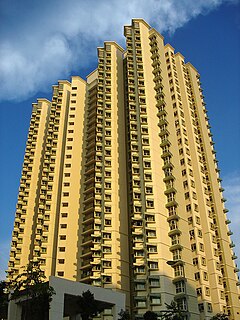A condominium, often shortened to condo, in the United States and in most Canadian provinces, is a type of living space similar to an apartment but independently sellable and therefore regarded as real estate. The condominium building structure is divided into several units that are each separately owned, surrounded by common areas that are jointly owned. Similar concepts in other English-speaking countries include strata title in Australia, Malaysia, New Zealand, and the Canadian province of British Columbia; commonhold in the United Kingdom; and sectional title in South Africa.
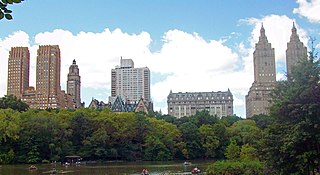
A housing cooperative, co-op, or housing company, is a legal entity, usually a cooperative or a corporation, which owns real estate, consisting of one or more residential buildings; it is one type of housing tenure. Housing cooperatives are a distinctive form of home ownership that have many characteristics that differ from other residential arrangements such as single family home ownership, condominiums and renting.
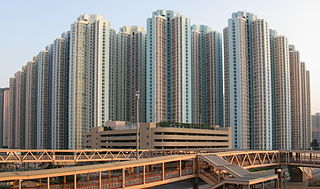
The Home Ownership Scheme is a subsidized-sale programme of public housing in Hong Kong managed by the Hong Kong Housing Authority. It was instituted in the late 1970s as part of the government policy for public housing with two aims - to encourage better-off tenants of rental flats to vacate those flats for re-allocation to families in greater housing need; and also to provide an opportunity for home ownership to families unable to afford to buy in the private sector.
Tiong Bahru is a housing estate located within the Bukit Merah Planning Area, in the Central Region of Singapore. Tiong Bahru was constructed in the 1920s by the Singapore Improvement Trust, the predecessor to the Housing Development Board and an entity of the British colonial authority providing mass public housing in Singapore and is the oldest housing estate in Singapore. The main estate consists of 30 apartment blocks with over 900 units of two to five rooms. There are also high-rise Housing and Development Board (HDB) flats and condominiums along Boon Tiong Road, Jalan Membina and Kim Tian Road which surround the main estate.
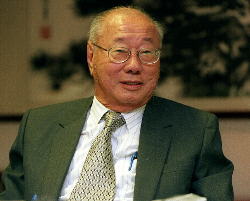
Lim Kim San was a Singaporean politician. He was credited for leading the successful public housing program in the Southeast Asian city-state during the early 1960s, which eased the acute housing shortage problem at that time.
Urban planning in Singapore has formulated and guided its physical development from the day Singapore was founded in 1819 as a British colony to the developed, independent country it is today. Urban planning is especially important due to land constraints and its high density.

Build To Order is a Housing and Development Board (HDB) flat allocation system that offers flexibility in timing and location for owners buying new HDB flats in Singapore. Eligible buyers planning to shift into a new HDB apartment in the near future, can apply for apartments in their preferred location from specific sites launched. Tender for construction will be called only if the number of applicants is at least 70% of the number of apartments in a specific contract, otherwise, the project is not built.
The Walk-in-Selection / Balloting Exercise of the Housing and Development Board in Singapore was a scheme that enables eligible flat buyers to book their apartment. It was replaced by Sale of Balance Flats (SOBF).

Tanjong Rhu is a subzone within the planning area of Kallang, Singapore, as defined by the Urban Redevelopment Authority (URA). The perimeter of Tanjong Rhu is made up of Nicoll Highway in the north; Mountbatten Road and Fort Road in the east; East Coast Parkway (ECP) in the south; as well as Marina Channel and Kallang Basin in the west. Tanjong Rhu is the largest in terms of physical area among the nine subzones that make up Kallang.
Design, Build and Sell Scheme was introduced by the Housing and Development Board in 2005. Flats built under the scheme were meant for public housing and developed by private developers. They were built with supposedly better designs and mostly in matured estates such as Tampines, Ang Mo Kio and Bishan. There were 13 DBSS projects, totaling 8,533 units. The scheme attracted public outrage when a series of five-room DBSS flats developed in Tampines by Sim Lian Group Limited opened for sale at S$880,000, way higher than what could be afforded by most middle-class families. As HDB did not control the pricing of DBSS units being sold, the scheme was poorly received and subsequently suspended indefinitely.
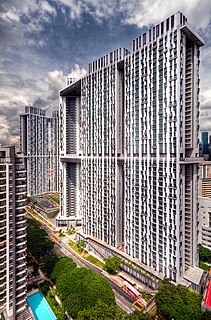
The Pinnacle@Duxton is a 50-storey residential development in Singapore's city center, next to the business district. The project features the world's two longest sky gardens of 500 metres (1,600 ft) each, on both the 26th and 50th floors. All seven connected towers are collectively the world's tallest public residential buildings.

Hillview is a neighbourhood nestled within the western region of Singapore. The neighbourhood overlooks the nearby Bukit Timah Hill, hence its name.
Additional Housing Grant is an additional subsidy over and above the regular market subsidy and Central Provident Fund Housing Grant that new and resale HDB flat buyers in Singapore can enjoy. It offsets the purchase price of a new or resale HDB flat in Singapore, thereby reducing the housing loan a flat buyer needs to take.
There is no legal recognition of same-sex unions in Singapore.
Housing and Urban Development Company (HUDC) flats are a type of housing unique to Singapore. They were first built in 1974 to cater to a sandwiched class of Singaporeans who can afford something better than the typical public housing, or HDB flats, but yet still find private housing unaffordable. Moreover, in the 1970s there were fewer private housing in the country.

Canberra Plaza is a future New Generation Neighbourhood Centre (NGNC) build by the Housing & Development Board (HDB), the government agency in charge of public housing development in Singapore. It is one of the new Neighbourhood Centres (NCs) being constructed by HDB in 10 years after the completion of Pioneer Mall and Punggol Plaza in 2004. Cable News Network (CNN) reported that Canberra Plaza will provide a "complete live-work-play-learn environment for residents and signifies Singapore's public housing for the future".


